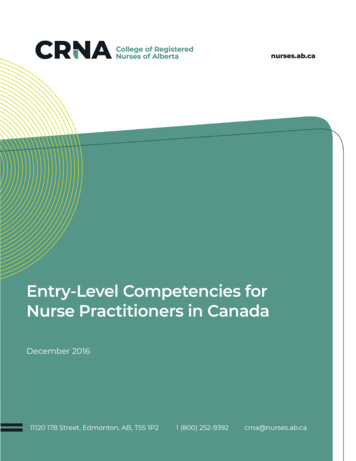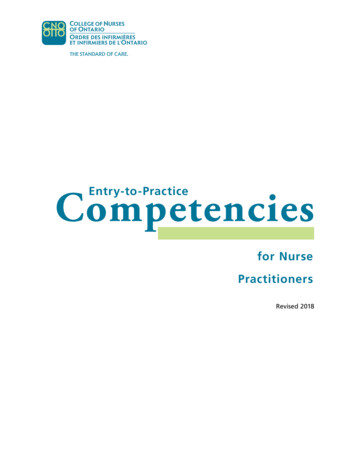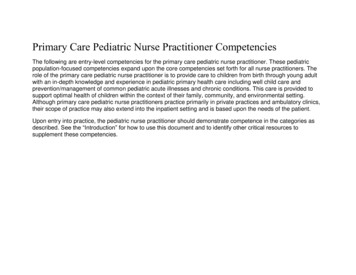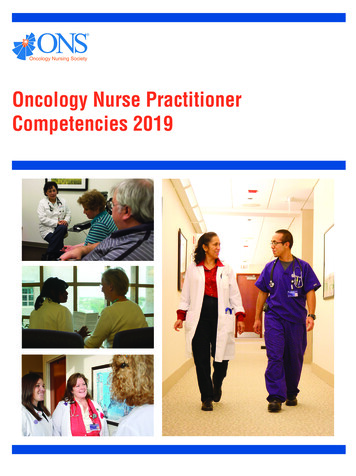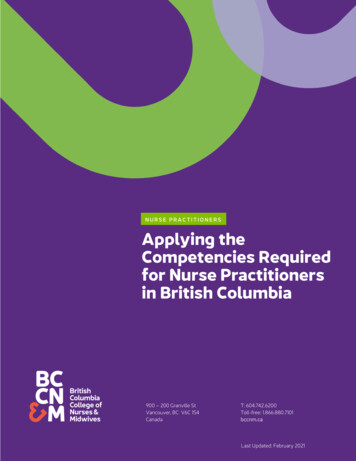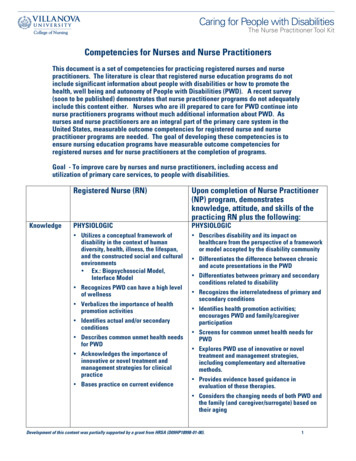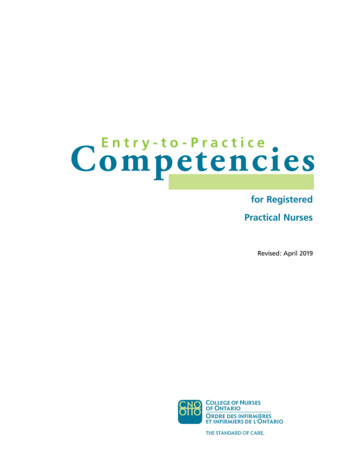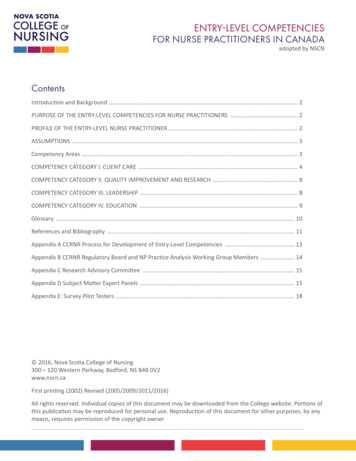
Transcription
ENTRY-LEVEL COMPETENCIESFOR NURSE PRACTITIONERS IN CANADAadopted by NSCNContentsIntroduction and Background . . 2PURPOSE OF THE ENTRY-LEVEL COMPETENCIES FOR NURSE PRACTITIONERS . 2PROFILE OF THE ENTRY-LEVEL NURSE PRACTITIONER . . 2ASSUMPTIONS . . 3Competency Areas . 3COMPETENCY CATEGORY I. CLIENT CARE . . 4COMPETENCY CATEGORY II. QUALITY IMPROVEMENT AND RESEARCH . . 8COMPETENCY CATEGORY III. LEADERSHIP . . 8COMPETENCY CATEGORY IV. EDUCATION . 9Glossary . 10References and Bibliography . 11Appendix A CCRNR Process for Development of Entry-Level Competencies . 13Appendix B CCRNR Regulatory Board and NP Practice Analysis Working Group Members . 14Appendix C Research Advisory Committee . 15Appendix D Subject Matter Expert Panels . . 15Appendix E: Survey Pilot Testers . . 18 2016, Nova Scotia College of Nursing300 – 120 Western Parkway, Bedford, NS B4B 0V2www.nscn.caFirst printing (2002) Revised (2005/2009/2011/2016)All rights reserved. Individual copies of this document may be downloaded from the College website. Portions ofthis publication may be reproduced for personal use. Reproduction of this document for other purposes, by anymeans, requires permission of the copyright owner.
Introduction and BackgroundThe Entry-Level Competencies for Nurse Practitioners reflect the knowledge, skills, and judgement requiredof nurse practitioners to provide safe, competent, ethical and compassionate care. While specific roles andresponsibilities may vary by context and client population, this document outlines the essential competenciesthat all nurse practitioners must possess to be proficient when they begin practice.The entry-level competencies outlined in this document were developed as part of a national analysis of threestreams of nurse practitioner practice: Family/All Ages (Primary care), Adult and Child/Pediatric undertaken bythe Canadian Council of Registered Nurse Regulators (CCRNR). The identified competencies were based on anextensive review of Canadian regulatory documents (e.g., provincial/ territorial competencies, standards, etc.),along with relevant research evidence and were validated through the practice analysis survey.See Appendix Afor the process used by CCRNR in the development of the nurse practitioner entry-level competencies.The CCRNR board established a national working group with representatives from all Canadian nursingregulatory bodies to coordinate all aspects of the practice analysis (Appendix B). In addition, a Research AdvisoryCommittee (Appendix C) and three Subject Matter Expert panels (Appendix D) were established to support theproject. Finally, 27 NPs from the three streams of practice completed a pilot test of the practice analysis survey(Appendix E).The entry-level competencies outlined in this document are the product of the Nurse Practitioner PracticeAnalysis carried out between February 2014 and May 2015, and reflect the trends in nurse practitioner practiceduring that timeframe. Other factors have an impact on healthcare delivery, necessitating nurse practitionersto develop knowledge and skill to effectively address these issues in their practice. Some of these factorsinclude cultural safety, the impact of power differentials in health service delivery with diverse populations, theincreasing prevalence of concerns with mental health and addictions in Canada, and the recommendations ofthe Truth and Reconciliation Commission of Canada (2015).PURPOSE OF THE ENTRY-LEVEL COMPETENCIES FOR NURSE PRACTITIONERSEntry-level competencies are one of the sentinel documents used by regulatory bodies in the regulation of nursepractitioner practice for the purpose of: recognition and approval of nurse practitioner education programs, development and approval of nurse practitioner entry-level examinations, assessment of nurse practitioners’ ongoing continuing competence, and providing information to the public, nurse practitioner education programs, employers and otherstakeholders on the regulatory expectations of nurse practitioner practicePROFILE OF THE ENTRY-LEVEL NURSE PRACTITIONERNurse practitioners are registered nurses with additional experience and nursing education at the Masterslevel, which enables them to autonomously diagnose, treat and manage acute and chronic1 physical andmental illnesses. As advanced practice nurses, they use their in-depth nursing and clinical knowledge toanalyze, synthesize and apply evidence to make decisions about their client’s healthcare. They apply theory andknowledge from nursing and other disciplines to provide a comprehensive range of essential health servicesgrounded in professional, ethical and legal standards within a holistic model of care. Nurse practitioners workcollaboratively with their clients to establish measurable goals, and identify and advocate to close gaps in healthoutcomes.The principles of primary health care are foundational to nurse practitioner practice. These principlesinclude accessibility, public participation, health promotion, use of appropriate technology and intersectoralcollaboration (WHO, 1996). This lens of primary health care facilitates nurse practitioner practice with diverse1In Quebec, initial diagnoses of chronic illnesses are made by physicians in primary care.2
client populations in a variety of contexts and practice settings including acute care, primary care, rehabilitativecare, curative and supportive care, and palliative/end-of-life care.In addition to their role in clinical care, nurse practitioners have the knowledge and skills to play a broader rolein the healthcare system. They provide leadership and collaborate with multiple stakeholders to improve healthoutcomes at the individual client, community and population health levels. Nurse practitioners understand theunique health needs of diverse populations, and the values that impact their access to care.Entry-level nurse practitioners require time and support from employers, mentors and the healthcare teamto consolidate their knowledge, skills and judgment, develop their individual approach to care delivery andestablish professional relationships. As they develop confidence in their clinical nurse practitioner role, theyintegrate and further develop their leadership, research and mentoring skills that are a critical part of nursepractitioner practice.ASSUMPTIONSThe nurse practitioner entry-level competencies are based on the following assumptions:1. Nurse practitioner practice is grounded in values, knowledge and theories of nursing practice.2. Entry-level competencies form the foundation for all aspects of nurse practitioner practice, and apply acrossdiverse practice settings and client populations.3. Entry-level competencies build and expand upon the competencies required of a registered nurse andaddress the knowledge, skills and abilities that are included in the nurse practitioners’ legislated scope ofpractice4. Nurse practitioners require graduate nursing education with a substantial clinical component.5. Collaborative relationships with other healthcare providers involve both independent and shared decisionmaking. All parties are accountable in the practice relationship as determined by their scopes of practice,educational backgrounds and competencies.Competency AreasThe entry-level competencies are organized into four competency categories: client care, quality improvementand research, leadership and education. The first competency area, client care, is further divided into sixsub-competency categories, which reflects the importance of the clinical dimension of the nurse practitionerprofessional role.I.Client CareA. Client Relationship Building and CommunicationB. AssessmentC. DiagnosisD. ManagementE. Collaboration, Consultation and ReferralF. Health PromotionII. Quality Improvement and ResearchIII. LeadershipIV. EducationA. Client, Community and Healthcare TeamB. Continuing Competence3
COMPETENCY CATEGORY I. CLIENT CAREA. Client Relationship Building and CommunicationThe competent, entry-level nurse practitioner uses appropriatecommunication strategies to create a safe and therapeuticenvironment for client care.1. Clearly articulate the role of the nurse practitioner when interacting with the client2. Use developmentally and culturally-appropriate communication techniques and tools3. Create a safe environment for effective and trusting client interaction where privacy and confidentiality aremaintained4. Use relational strategies (e.g., open-ended questioning, fostering partnerships) to establish therapeuticrelationships5. Provide culturally-safe care, integrating clients’ cultural beliefs and values in all client interactions6. Identify personal beliefs and values and provide unbiased care7. Recognize moral or ethical dilemmas, and take appropriate action if necessary (e.g., consult with others,involve legal system)8. Document relevant aspects of client care in client recordB. AssessmentThe competent, entry-level nurse practitioner integrates anevidence-informed knowledge base with advanced assessmentskills to obtain the necessary information to identify clientdiagnoses, strengths, and needs.1. Establish the reason for the client encountera. Review information relevant to the client encounter (e.g., referral information, information from otherhealthcare providers, triage notes) if availableb. Perform initial observational assessment of the client’s conditionc. Ask pertinent questions to establish the context for client encounter and chief presenting issued. Identify urgent, emergent, and life-threatening situationse. Establish priorities of client encounter2. Complete relevant health history appropriate to the client’s presentationa. Collect health history such as symptoms, history of presenting issue, past medical and mental healthhistory, family health history, pre-natal history, growth and development history, sexual history, allergies,prescription and OTC medications, and complementary therapiesb. Collect relevant information specific to the client’s psychosocial, behavioral, cultural, ethnic, spiritual,developmental life stage, and social determinants of healthc. Determine the client’s potential risk profile or actual risk behaviors (e.g., alcohol, illicit drugs and/or4
controlled substances, suicide or self-harm, abuse or neglect, falls, infections)d. Assess client’s strengths and health promotion, illness prevention, or risk reduction needs3. Perform assessmenta. Based on the client’s presenting condition and health history, identify level of assessment (focused orcomprehensive) required, and perform review of relevant systemsb. Select relevant assessment tools and techniques to examine the clientc. Perform a relevant physical examination based on assessment findings and specific client characteristics(e.g., age, culture, developmental level, functional ability)d. Assess mental health, cognitive status, and vulnerability using relevant assessment toolse. Integrate laboratory and diagnostic results with history and physical assessment findingsC. DiagnosisThe competent, entry-level nurse practitioner integrates anevidence-informed knowledge base with advanced assessmentskills to obtain the necessary information to identify clientdiagnoses, strengths, and needs.The competent, entry-level nurse practitioner is engaged in the diagnostic process and develops differentialdiagnoses through identification, analysis, and interpretation of findings from a variety of sources.1. Determine differential diagnoses for acute, chronic, and life threatening conditionsa. Analyze and interpret multiple sources of data, including results of diagnostic and screening tests, healthhistory, and physical examinationb. Synthesize assessment findings with scientific knowledge, determinants of health, knowledge of normaland abnormal states of health/illness, patient and population-level characteristics, epidemiology, healthrisksc. Generate differential diagnosesd. Inform the client of the rationale for ordering diagnostic testse. Determine most likely diagnoses based on clinical reasoning and available evidencef. Order and/or perform screening and diagnostic investigations using best available evidence to support orrule out differential diagnosesg. Assume responsibility for follow-up of test resultsh. Interpret the results of screening and diagnostic investigations using evidence-informed clinicalreasoningi. Confirm most likely diagnoses22. Explain assessment findings and communicate diagnosis to clienta. Explain results of clinical investigations to clientb. Communicate diagnosis to client, including implications for short- and long-term outcomes andprognosisc. Ascertain client understanding of information related to findings and diagnoses5
D. ManagementThe competent, entry-level nurse practitioner, on the basis ofassessment and diagnosis, formulates the most appropriateplan of care for the client, implementing evidence-informedtherapeutic interventions in partnership with the client tooptimize health.1. Initiate interventions for the purpose of stabilizing the client in, urgent, emergent, and life-threateningsituations (e.g., establish and maintain airway, breathing and circulation; suicidal ideation)2. Formulate plan of care based on diagnosis and evidence-informed practicea. Determine and discuss options for managing the client’s diagnosis, incorporating client considerations(e.g., socioeconomic factors, geography, developmental stage)b. Select appropriate interventions, synthesizing information including determinants of health, evidenceinformed practice and client preferencesc. Initiate appropriate plan of care (e.g. non-pharmacological, pharmacological, diagnostic tests, referral)d. Consider resource implications of therapeutic choices (e.g. cost, availability)3. Provide pharmacological interventions, treatment, or therapya. Select pharmacotherapeutic options as indicated by diagnosis based on determinants of health,evidence-informed practice, and client preferenceb. Counsel client on pharmacotherapeutics, including rationale, cost, potential adverse effects, interactions,contraindications and precautions as well as reasons to adhere to the prescribed regimen and requiredmonitoring and follow upc. Complete accurate prescription(s) in accordance with applicable jurisdictional and institutionalrequirementsd. Establish a plan to monitor clients’ responses to medication therapy and continue, adjust or discontinuea medication based on assessment of the client’s response.e. Apply strategies to reduce risk of harm involving controlled substances, including medication abuse,addiction, and diversion4. Provide non-pharmacological interventions, treatments, or therapiesa. Select therapeutic options (including complementary and alternative approaches) as indicated bydiagnosis based on determinants of health, evidence-informed practice, and client preferenceb. Counsel client on therapeutic option(s), including rationale, potential risks and benefits, adverse effects,required after care, and follow-upc. Order required treatments (e.g., wound care, phlebotomy)d. Discuss and arrange follow-up5. Perform invasive and non-invasive proceduresa. Inform client about the procedure, including rationale, potential risks and benefits, adverse effects, andanticipated aftercare and follow-upb. Obtain and document informed consent from the clientc. Perform procedures using evidence-informed techniquesd. Review clinical findings, aftercare, and follow-up6. Provide oversight of care across the continuum for clients with complex and/or chronic conditions7. Follow up and provide ongoing managementa. Develop a systematic and timely process for monitoring client progressb. Evaluate response to plan of care in collaboration with the clientc. Revise plan of care based on client’s response and preferences6
E: Collaboration, Consultation, and ReferralThe competent, entry-level nurse practitioner identifies whencollaboration, consultation, and referral are necessary for safe,competent, and comprehensive client care.1. Establish collaborative relationships with healthcare providers and community-based services (e.g., school,police, child protection services, rehabilitation, home care)2. Provide recommendations or relevant treatment in response to consultation requests or incoming referrals3. Identify need for consultation and/or referral (e.g., to confirm a diagnosis, to augment a plan of care, toassume care when a client’s health condition is beyond the nurse practitioner’s individual competence orlegal scope of practice)4. Initiate a consultation and/or referral, specifying relevant information (e.g., client history, assessmentfindings, diagnosis) and expectations5. Review consultation and/or referral recommendations with the client and integrate into plan of care asappropriateF. Health PromotionThe competent, entry-level nurse practitioner uses evidenceand collaborates with community partners and other healthcareproviders to optimize the health of individuals, families,communities, and populations.1. Identify individual, family, community and/or population strengths and health needs to collaborativelydevelop strategies to address issues2. Analyze information from a variety of sources to determine population trends that have health implications3. Select and implement evidence-informed strategies for health promotion and primary, secondary, andtertiary prevention4. Evaluate outcomes of selected health promotion strategies and revise the plan accordingly7
COMPETENCY CATEGORY II. QUALITY IMPROVEMENT AND RESEARCHThe competent, entry-level nurse practitioner uses evidenceinformed practice, seeks to optimize client care and healthservice delivery, and participates in research.1. Identify, appraise, and apply research, practice guidelines, and current best practice2. Identify the need for improvements in health service delivery3. Analyze the implications (e.g., opportunity costs, unintended consequences) for the client and/or the systemof implementing changes in practice4. Implement planned improvements in healthcare and delivery structures and processes5. Participate in quality improvement and evaluation of client care outcomes and health service delivery6. Identify and manage risks to individual, families, populations, and the healthcare system to support qualityimprovement7. Report adverse events to clients and/or appropriate authorities, in keeping with relevant legislation andorganizational policies8. Analyze factors that contribute to the occurrence of adverse events and near misses and develop strategiesto mitigate risks9. Participate in research10. Contribute to the evaluation of the impact of nurse practitioner practice on client outcomes and healthcaredelivery.COMPETENCY CATEGORY III. LEADERSHIPThe competent entry-level nurse practitioner demonstratesleadership by using the nurse practitioner role to improve clientcare and facilitate system change.1. Promote the benefits of the nurse practitioner role in client care to other healthcare providers andstakeholders (e.g., employers, social and public service sectors, the public, legislators, policy-makers)2. Implement strategies to integrate and optimize the nurse practitioner role within healthcare teams andsystems to improve client care3. Coordinate interprofessional teams in the provision of client care4. Create opportunities to learn with, from, and about other healthcare providers to optimize client care5. Contribute to team members’ and other healthcare providers’ knowledge, clinical skills, and client care (e.g.,by responding to clinical questions, sharing evidence)6. Identify gaps and/or opportunities to improve processes and practices, and provide evidence-informed8
recommendations for change7. Utilize theories of and skill in communication, negotiation, conflict resolution, coalition building, and changemanagement8. Identify the need and advocate for policy development to enhance client care9. Participate in program planning and development to optimize client careCOMPETENCY CATEGORY IV. EDUCATIONThe competent, entry-level nurse practitioner integrates formaland informal education into practice. This includes but is notlimited to educating self, clients, the community, and membersof the healthcare team.Client, Community, and Healthcare Team Education1. Assess and prioritize learning needs of intended recipients2. Apply relevant, theory-based, and evidence-informed content when providing education3. Utilize applicable learning theories, develop education plans and select appropriate delivery methods,considering available resources (e.g., human, material, financial)4. Disseminate knowledge using appropriate delivery methods (e.g., pamphlets, visual aids, presentations,publications)5. Recognize the need for and plan outcome measurements (e.g., obtaining client feedback, conduct pre- andpost-surveys)Continuing Competence6. Engage in self-reflection to determine continuing education competence needs7. Engage in ongoing professional development8. Seek mentorship opportunities to support one’s professional development9
GlossaryAdvanced nursing practice: “An umbrella term describing an advanced level of clinical nursing practice thatmaximizes the use of graduate educational preparation, in-depth nursing knowledge, and expertise in meetingthe health needs of individuals, families, groups, communities and populations. It involves analyzing andsynthesizing knowledge; understanding, interpreting and applying nursing theory and research; and developingand advancing nursing knowledge and the profession as a whole” (CNA, 2008).Adverse event: An event that results in unintended harm to the client and is related to the care and/or serviceprovided to the client, rather than the client’s underlying condition (CNA, 2010).Advocate: To actively support a right and good cause; to support others in speaking for themselves; to speak onbehalf of those who cannot speak for themselves (CNA, 2010).Client: “Individuals, families, groups, populations or entire communities who require nursing expertise. Theterm “client” reflects the range of individuals and/or groups with whom nurses may be interacting. In somesettings, other terms may be used such as patient or resident. In education, the client may also be a student; inadministration, the client may also be an employee; and in research, the client is usually a subject or participant”(NANB, 2010a).Collaboration: “Client care involving joint communication and decision-making processes among the client,nurse practitioner and other members of a health-care team who work together to use their individual andshared knowledge and skills to provide optimum client-centred care. The health-care team works with clientstoward the achievement of identified health outcomes, while respecting the unique qualities and abilities ofeach member of the group or team” (CNA, 2010).Competence: The ability to integrate and apply the knowledge, skills, abilities and judgment required to practisesafely and ethically with a designated client population in a specific nurse practitioner role and practice setting(NSCN, 2011).Competencies: The specific knowledge, skills, abilities, and judgment required for a nurse practitioner to practisesafely and ethically with a designated client population in a specific role and practice setting (NSCN, 2011).Complementary and alternative therapies: Health modalities or interventions that tend to be used alongsideconventional healthcare services, while alternative therapies tend to be used in place of conventional healthcare(CRNBC, 2012).Consultation: A request for another health professional’s advice on the care of a client. The goal is to enhancepatient care and/or improve the skills and confidence of the professional making the request (consultee). Theconsultant may or may not see the client directly. The responsibility for clinical outcomes remains with theconsultee, who is free to accept or reject the advice of the consultant (NSCN, 2011).Cultural safety: “Cultural safety is an outcome based on respectful engagement that recognizes and strives toaddress power imbalances inherent in the healthcare system. It results in an environment free of racism anddiscrimination, where people feel safe when receiving health care” (First Nations Health Authority, 2015).Determinants of health: The range of social, economic, geographic and systemic factors that influence a person’shealth status and outcomes. These factors include: access to appropriate health services, biology, copingabilities, culture, education, employment and working conditions, environment (natural and built, emotional andpsychological), gender, genetics, health behaviours, income, lifestyle, and social status (CNA, 2010).Entry-level competencies: The specific knowledge, skills, abilities, and judgment required for a newly-graduatednurse practitioner to meet the minimum requirements for entry to practise (NANB, 2010a).10
Evidence-informed practice: An approach to clinical practice that requires the nurse practitioner toconscientiously integrate critically appraised evidence with their experience and knowledge of contextual factorsto decide (in consultation with clients) what best suits clients’ needs. Evidence may include, but is not limitedto, published and unpublished research, clinical practice guidelines, consensus statements, expert advice, andquality assurance and patient safety data (CNA, 2010).Health: “A state of complete physical, mental, spiritual and social wellbeing, and not merely the absence ofdisease” (WHO, 1946).Health promotion: The process of enabling people to increase control over and improve their health. Itembraces actions directed not only at strengthening the skills, confidence and capabilities of individuals, butalso at changing social, environmental, political and economic conditions to alleviate their impact on public andindividual health (CNA, 2010).Referral: An explicit request for another health professional to become involved in the care of a client.Accountability for clinical outcomes is negotiated between the health care professionals involved (NSCN, 2011).Scope of practice: The roles, functions, and accountabilities that nurse practitioners are educated andauthorized to perform, as established through legislated definitions of nurse practitioner practice, andcomplemented by standards, guidelines and policy positions issued by nursing regulators (CARNA, 2011).Standards: Authoritative statements that describe the required behavior of every nurse practitioner, and areused to evaluate individual performance. They provide a benchmark below which performance is unacceptable(CNA, 2010).References and BibliographyAssociation of Registered Nurses of Newfoundland and Labrador. (2013). Standards for nurse practitionerpractice in Newfoundland and Labrador. St. John’s, NL: Author.Association of Registered Nurses of Prince Edward Island. (2012a). Nurse practitioner standards for practice.Charlottetown, PEI: Author.Association of Registered Nurses of Prince Edward Island. (2012b). Nurse practitioner core competencies.Charlottetown, PEI: Author.Bryant-Lukosius, D., & DiCenso, A. (2004). A framework for the introduction and evaluation of advanced practicenursing roles. Journal of Advanced Nursing, 48(5), 530-540.Canadian Council of Registered Nurse Regulators and Professional Examination Services. (2015). Practice AnalysisStudy of Nurse Practitioners. Beaverton, ON: Author.Canadian Nurses Association. (2010). Canadian Nurse Practitioner Core Competency Framework. Retrieved fromhttp:// cna-aiic.ca/ /media/cna/files/en/competency framework 2010 e.pdfCollege and Association of Registered Nurses of Alberta. (2011a). Nurse practitioner (NP) competencies.Edmonton, AB: Author.College and Association of Registered Nurses of Alberta. (2011b). Scope of practice for nurse practitioners (NPs).Edmonton, AB: Author.College des Medecins du Québec et Ordre des infirmières at infirmiers du Québec. (2013). Ligne directrices:Pratique clincique de infirmières praticienne specialisée en soins de première ligne (2e ed.). Montréal:Author.College of Registered Nurses of British Columbia. (2011). Competencies required for nurse practitioners in BritishColumbia. Vancouver, BC: Author.11
College of Registered Nurses of British Columbia. (2012a). Professional standards for registered nurses and nursepractitioners. Vancouver, BC: Author.College of Registered Nurses of British Columbia. (2012
The nurse practitioner entry-level competencies are based on the following assumptions: 1. Nurse practitioner practice is grounded in values, knowledge and theories of nursing practice. 2. Entry-level competencies form the foundation for all aspects of nurse practitioner practice, and apply across diverse practice settings and client .

